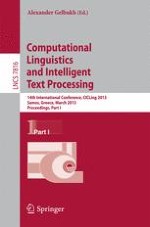This two-volume set, consisting of LNCS 7816 and LNCS 7817, constitutes the thoroughly refereed proceedings of the 13th International Conference on Computer Linguistics and Intelligent Processing, CICLING 2013, held on Samos, Greece, in March 2013. The total of 91 contributions presented was carefully reviewed and selected for inclusion in the proceedings. The papers are organized in topical sections named: general techniques; lexical resources; morphology and tokenization; syntax and named entity recognition; word sense disambiguation and coreference resolution; semantics and discourse; sentiment, polarity, subjectivity, and opinion; machine translation and multilingualism; text mining, information extraction, and information retrieval; text summarization; stylometry and text simplification; and applications.
